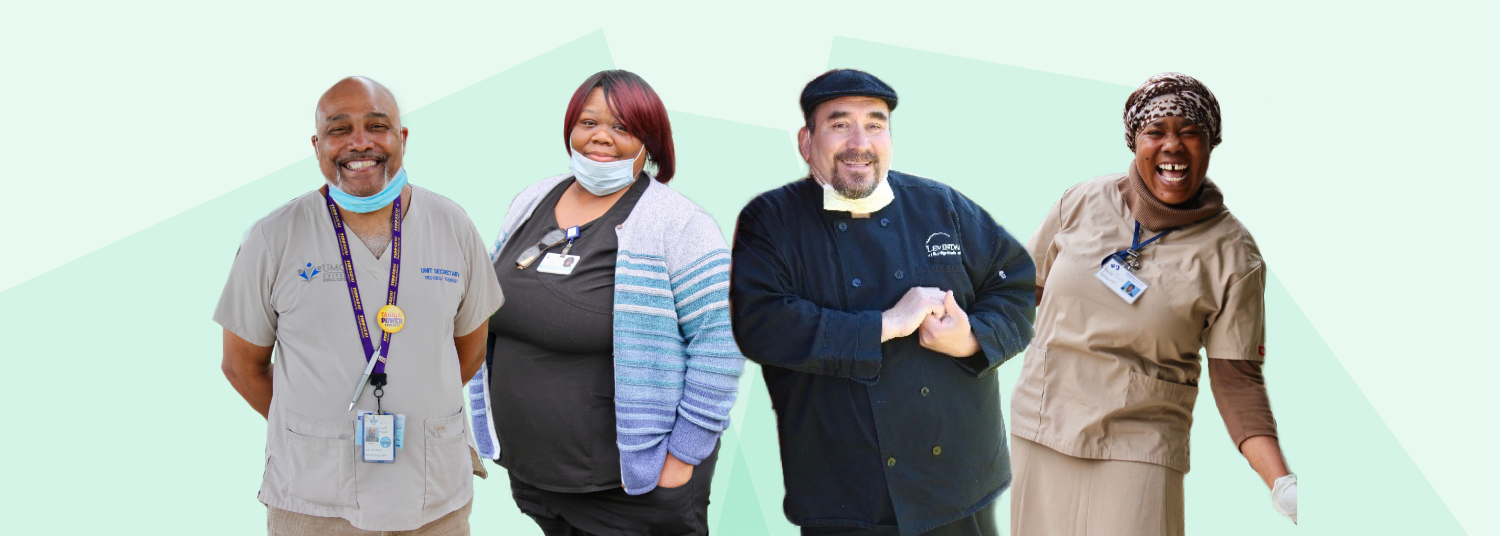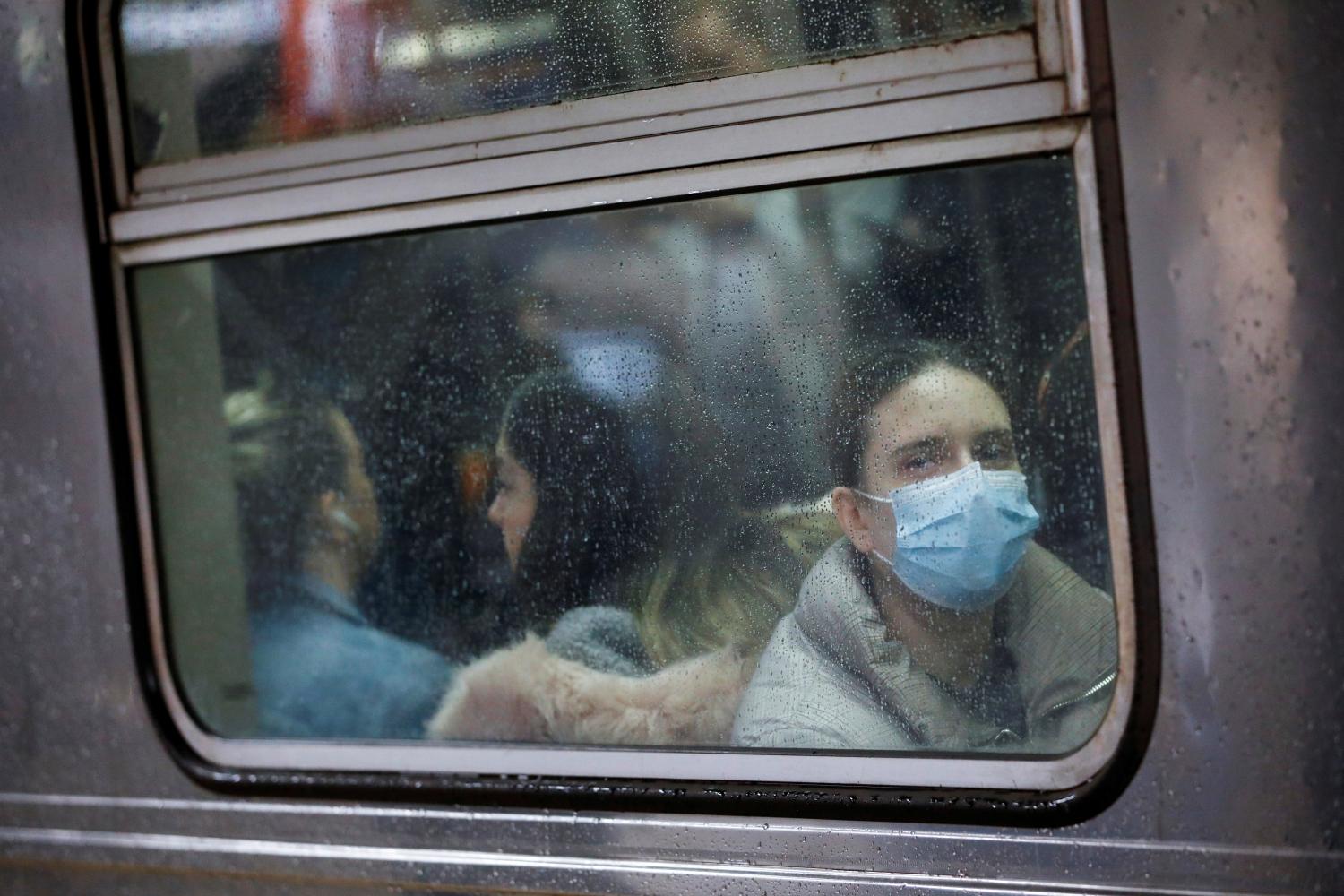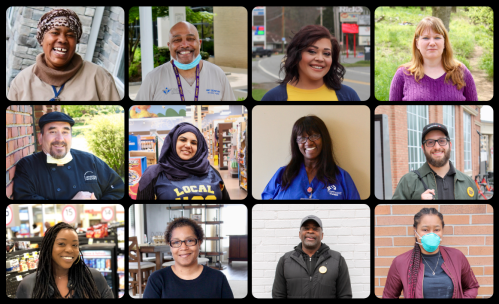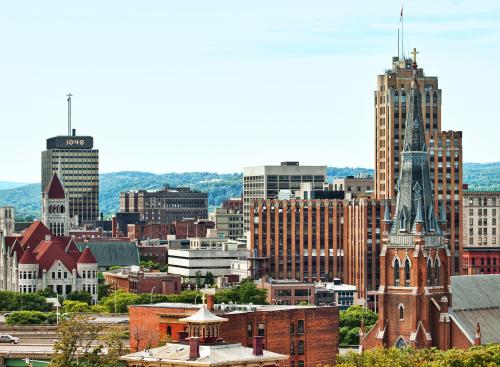This is the second post in a series on COVID-19 frontline workers. Read the stories of the workers profiled here.
Contents:
- Introduction
- Underpaid, undervalued, and essential
- A policy agenda for essential, low-wage health workers:
- Keep all health workers safe
- Introduce hazard pay
- Raise pay to a permanent living wage
- Expand paid leave
- Give workers the respect they deserve
Introduction
The COVID-19 pandemic has inspired an outpouring of public appreciation for the country’s frontline heroes, from television ads to firefighter salutes to essential worker toys. But while doctors and nurses deserve our praise, they are not the only ones risking their lives during the pandemic—in fact, they represent less than 20% of all essential health workers.
Too often, we overlook the heroism and dignity of millions of low-paid, undervalued, and essential health workers like Sabrina Hopps, a 46-year-old housekeeping aide in an acute nursing facility in Washington, D.C.
“If we don’t clean the rooms correctly, the pandemic will get worse,” said Hopps. She cares deeply about the patients she works with, and knows that the value of her job goes well beyond cleaning. “It’s me and the other housekeepers who sit and talk with [patients] to brighten up their day, because they can’t have family members visiting.”
Despite her contributions, she doesn’t feel recognized. “Housekeeping has never been respected,” she told me recently. “When you think about health care work, the first people you think about are the doctors and the nurses. They don’t think about housekeeping, maintenance, dietary, nursing assistants, patient care techs, and administration.”
Hopps is one of millions of low-wage essential health workers on the COVID-19 front lines. Like the higher-paid doctors and nurses they work alongside, these essential workers are risking their lives during the pandemic—but with far less prestige and recognition, very low pay, and less access to the protective equipment that could save their lives. They are nursing assistants, phlebotomists, home health aides, housekeepers, medical assistants, cooks, and more. The vast majority of these workers are women, and they are disproportionately people of color. Median pay is just $13.48 an hour.
Over the last several weeks, I interviewed nearly a dozen low-wage health workers on the front lines of COVID-19. (You can read their stories here.) Despite being declared “essential,” the workers I interviewed described feeling overlooked and deprioritized, even expendable. They spoke with pride about their work, but few felt respected, even as they put their lives on the line. Many expressed frustration—and sometimes anger—over their lack of life-saving protective equipment.
It is long past time that these workers are treated as truly essential. This starts with simply recognizing the value of workers like Hopps—but we can and must do more. The policy recommendations in this report aim to keep these workers safe on the job, compensate them with a living wage, support them if they fall ill, and give them the respect and appreciation they deserve.
Underpaid, undervalued, and essential
The underpaid but essential health care workforce in America comprises nearly 7 million people in low-paid health jobs in these three categories:
- Health care support workers assist health care providers such as doctors and nurses in providing patient care. Roles include orderlies, medical assistants, phlebotomists, and pharmacy aides.
- Direct care workers such as home health workers, nursing assistants, and personal care aides provide care to individuals with physical, cognitive, or other needs.
- Health care service workers include housekeepers, janitors, and food preparation and serving workers employed in health care settings such as hospitals and nursing homes.
More people are employed in health care support, service, and direct care jobs than in all health care practitioner and technician jobs (doctors, nurses, EMTs, lab technicians, etc.). In fact, more people work in hospitals as housekeepers and janitors—like Sabrina Hopps—than as physicians and surgeons. The size of this low-wage health workforce exceeds the size of most other occupational groups of essential workers. It employs more people than the entire transportation and warehousing industry and more than twice as many people as the grocery industry.
Median wages in health care support, service, and direct care jobs were just $13.48 an hour in 2019—well short of a living wage and far lower than the median pay of doctors (over $100 per hour) and nurses ($35.17 per hour). Home health and personal care workers earn even less, with a median hourly wage of only $11.57. The wages are so low that nearly 20% of care workers live in poverty and more than 40% rely on some form of public assistance. These fields are some of the fastest-growing of all occupations, with more than a million new jobs projected by 2028.
Table 1. Demographic profile of workers in the health care and social assistance industry, 2019
| Occupation | Number of workers | Median hourly wage | % Women | % African American | % Latino or Hispanic |
| All health care support, direct care, and service workers | 6,964,410 | $13.48 | 81% | 25% | 21% |
| Registered nurses | 2,604,000 | $35.17 | 89% | 12% | 7% |
| Physicians and surgeons | 562,440 | >$100 | 41% | 8% | 8% |
Source: Brookings analysis of U.S. Bureau of Labor Statistics’ Occupational Employment Statistics and the U.S. Census Bureau’s Current Population Survey.
Over 80% of health care support, service, and direct care workers are women. They are also disproportionately people of color. Like other low-wage jobs where women and people of color are concentrated, many of these positions are plagued by underinvestment and a lack of benefits. Now, these jobs pose an even greater risk to workers’ lives.
Despite being undervalued, low-wage health workers make essential contributions during the pandemic and beyond. “Nobody is insignificant,” said Tony Powell, a 62-year-old administrative coordinator of a hospital surgical unit in Washington, D.C. “Without environmental service, without dietary, without secretaries, without medical and surgical techs and certified nursing assistants (CNAs), it wouldn’t be a hospital.” Home health workers, for instance, provide the first line of defense against COVID-19 for millions of elderly and vulnerable people living at home. Without that, the limited capacity of hospitals today would be stretched even further.
A policy agenda for essential, low-wage health workers
Policymakers, employers, and the general public should each do their part for low-wage essential health workers during COVID-19 and beyond. The following policy recommendations are aimed at keeping these workers safe on the job, compensating them with a living wage, supporting them if they fall ill, and giving them the respect and appreciation they deserve.
Keep all health workers safe
A first-order priority for policymakers and employers should be keeping frontline health workers safe on the job. Dire shortages of life-saving personal protective equipment (PPE) such as surgical masks, N95 respirators, isolation gowns, gloves, and face shields are jeopardizing workers’ lives. One poll showed that two-thirds of health care workers reported insufficient face masks as recently as early May. Frustrated nurses and doctors have made urgent appeals to the federal government to activate the Defense Production Act to mobilize production of needed supplies.
While most news coverage highlights only the risks to nurses and doctors, PPE shortages are also a matter of life and death for millions of health care support, service, and direct care workers on the COVID-19 front line. These workers are at a lower priority for the already-insufficient supplies, meaning that hospitals and health care facilities sometimes overlook their safety as they ration PPE and prioritize vulnerable clinical staff who treat infectious patients.
The workers I interviewed expressed a range of emotions—from fear to frustration to anger—over their lack of access to PPE. David Saucedo, a 52-year-old cook at a Baltimore nursing home, said his supervisors initially denied his requests for PPE.
“Just because I am not a nurse or nursing assistant doesn’t mean I don’t come in contact with patients,” Saucedo told me. “Every footstep a nurse, nursing assistant, or doctor takes in that facility, I actually walk right behind them.” His Alzheimer’s patients, he noted, do not understand social distancing: “They just come up to you, grab you, and sit and talk to you.”
Saucedo had to argue his case to two supervisors before he was finally given the PPE that nurses in his facilities automatically access. “It’s like they prioritized them and forgot about everyone else,” he told me. “It makes me feel like I am secondary, not equal. You are expendable, in a way.”
Andrea (who preferred we only use her first name), a 29-year-old housekeeping aide in a hospital operating room and mother of two young children, had a similar experience. After a patient in a room she was responsible for cleaning was suspected of having the coronavirus, Andrea asked her charge nurse to be fit-tested for an N95 mask. Andrea said the nurse’s response was, “No, these are for special people.”
“One minute you are important enough,” she told me. “The next minute it is like, no you aren’t that important to get the proper equipment, but you are important enough to clean it for the next patient.”
Home care workers face additional hurdles to accessing PPE. Their employers are much lower in priority for state and federal PPE supplies than hospitals, nursing homes, and emergency services, leaving many agencies struggling to procure equipment on their own and pay for its skyrocketing costs on the private market. A recent survey found more than 75% of home care agencies face shortages of masks and sanitizer.
Like others in her field, Elizabeth Peachy, a 49-year-old home health aide in Virginia, received no PPE, COVID-19 training, or supplies from her employer. She described driving to towns across Virginia and West Virginia in search of her own equipment. Yvette Beatty, a 60-year-old home health aide in Philadelphia, said her employer was unable to access PPE despite concerted efforts.
“I would love to see us have hazard masks, instead of putting cloths over our face, or going to the Dollar Store and buying dollar masks,” Beatty told me. “We need equipment. They need to give equipment to agencies. We are running around with cloths, no protective gear. We need the exact same thing as everyone else.”
» Policy recommendations to keep workers safe:
- The federal government should fully utilize the Defense Production Act to mobilize manufacturers across the country to increase the supply of PPE. Until every health care worker has sufficient access to PPE, their lives are at risk.
- State governments should encourage companies to increase PPE supplies and help home health agencies access supplies and finance costs. They can follow the lead of Washington state, which recently added home health workers and other long-term care providers to the top tier of priority for PPE.
- Home care agencies should increase training, information, and resources to frontline workers, so home care workers do not feel like they are navigating a pandemic on their own.
Introduce hazard pay
The extremely low pay that health care support, service, and direct care workers earn has long been woefully inadequate. During a pandemic, it is morally reprehensible. Congress should enact hazard pay to ensure that no worker risking his or her life during this crisis is paid less than a family-sustaining wage.
For workers in health jobs, federal funding for hazard pay is especially important. Hospital finances have been hit hard by the pandemic. Home care agencies are limited in their ability to raise pay due to Medicaid reimbursement rates, a major systemic impediment to improving job quality for millions of care workers. Hazard pay for health workers has lagged behind temporary pay increases for workers in sectors such as retail and grocery.
Lawmakers on both sides of the aisle have offered proposals for federally funded hazard pay. In April, President Donald Trump signaled his support for extra compensation to doctors, nurses, and health workers. On May 15, the House of Representatives passed the HEROES Act, which included $200 billion for hazard pay for essential workers. Despite this momentum, U.S. lawmakers have not passed hazard pay into law. In Canada, however, Prime Minister Justin Trudeau announced a $4 billion commitment to increase pay for essential workers. He singled out low-paid essential workers as a priority, saying that minimum-wage workers risking their health during the pandemic deserve a raise.
The workers I interviewed expressed a strong desire for hazard pay. David Saucedo likened the hazards of his job as a nursing home cook to the risks he faced during his military service: “When I was in the Navy, when we went to war, I was getting paid hazardous duty pay. To me, it is a hazardous job right now. We should be getting paid hazardous pay.” Saucedo noted that additional compensation could be life-saving, affording his colleagues the chance to take a taxi instead of risking exposure to COVID-19 on public transit. “Everybody is contagious on buses,” he said. “The best thing you can do is limit their amount of exposure for a cook or anyone else.”
Housekeeping aide Sabrina Hopps agreed that additional compensation could be life-saving. “If pay was better, I would be able to live on my own and so could my children,” she told me. “What I make, it is not enough. So, I am forced to share an apartment with my son and daughter and my granddaughter. Going back and forth to work, I am jeopardizing their lives.” Hopps is especially concerned for her son, who has asthma and is a cancer survivor. Her employer recently introduced a new bonus for employees providing direct patient care, but excluded housekeepers and other low-paid service workers from the additional compensation.
» Policy recommendations for introducing hazard pay:
- Congress should pass federally mandated hazard pay for at-risk essential workers in the next pandemic relief bill, with a priority for lower-paid workers. Hazard pay should double the wages of low-wage workers. In the HEROES Act legislation, House Democrats included $200 billion for hazard pay through a “Heroes Fund” that would administer grants to employers of essential workers. Their proposed rate of an additional $13 per hour is roughly equivalent to the median wage of health care support, service, and direct care workers.
Raise pay to a permanent living wage
COVID-19 has laid bare the wide gap between the value that health care support, service, and direct care workers bring to society and the extremely low wages they earn in return. Short-term fixes such as hazard pay are urgently needed. But policymakers and employers should also make lasting changes so that these essential workers finally earn a permanent living wage.
Hospital administrative coordinator Tony Powell explained why wage increases are so critical for low-paid health workers: “They have to realize that these people, just like any other people—doctors, nurses, whoever—they have families. They have to raise their families, too. If you are working just at the poverty level, that is giving you enough to get to work, get lunch, and try to send your kids to school. But without a living wage, it’s not going to mean anything.”
Pauline Moffitt, a 50-year-old direct care worker in Philadelphia, is barely surviving on the poverty wages she earns caring for immunocompromised and elderly residents. At $9 an hour, her pay is so low that Moffitt and her recently laid-off husband cannot make ends meet, even as she commutes nearly three hours each way on five bus and train transfers. “It is a struggle,” she told me. “I have to pay a lot of bills. What am I supposed to do? I pray always: Lord, please stretch my pay. Please.”
Pennsylvania, where Moffitt works, is one of the 21 states that has not mandated a minimum wage above the federal rate of $7.25 per hour. She wants to see permanent pay increases. “I just wish they would raise it and give us a little more,” she said. “Not just for me, but all the other home health aides that are in the same situation.”
» Policy recommendations for permanently boosting pay:
- The federal government and state and local governments should raise the minimum wage to at least $15 per hour.
- State governments and the federal government should increase Medicaid funding to allow employers of home care workers to provide a living wage and offer benefits.
Expand paid leave
While workers of all incomes are vulnerable to COVID-19, low-wage workers have the least access to paid leave if they fall ill. In 2019, less than a third of workers in the bottom 10% of income earnings had access to paid sick leave, compared to nine out of 10 higher-paid workers in the top quarter of income earnings. The gaps for essential workers like home health aides are particularly large—a 2017 survey of 3,000 home care workers found that less than one in five care workers had access to paid leave.
“We don’t get any benefits,” said Elizabeth Peachy, a 49-year-old home health aide who earns $9 an hour. The funding for her work caring for geriatric patients comes through the state of Virginia, but she is not employed directly by the state. “They have us work as independent contractors,” she told me. “And that way, we get no sick leave, no overtime, no benefits at all. This is pretty standard.”
Peachy thinks policymakers should make changes: “In reality, it is a lot cheaper to pay us a little more money, give us some benefits, and allow us to take care of those patients, keep those patients from being in an ER or a nursing home, and help them have a good quality of life in their own home.”
Low-wage health workers without paid leave are in an impossible position. They face some of the highest risks of exposure to COVID-19, but have little or no ability to stay home to care for themselves or their loved ones. The public health stakes during a pandemic are high—rushing back to their jobs before they are fully recovered jeopardizes workers’ well-being and risks spreading the coronavirus to patients and colleagues. “The problem is you are going to have some workers who are still going to go to work,” said Peachy. “And they shouldn’t, because they may be sick and they may get the person sick. It would be better to have paid sick days because we need these workers to go into homes and take care of the thousands of high-risk people.”
The Families First Coronavirus Response Act took steps to temporarily address this disparity and expand paid sick leave and family and medical leave to workers during the pandemic. However, two gaps in the legislation undermine these benefits for low-wage health workers. First, the legislation only applies to employers with less than 500 employees, which could exclude upwards of half of all workers. It also stipulates that employers may exempt “health care providers,” broadly defined by the Department of Labor to include workers across health care institutions and home care settings.
» Policy recommendations for expanding paid sick leave:
- In the next pandemic relief bill, Congress should revoke exemptions for large employers and expand access to temporary paid sick leave and family and medical leave to all workers. The HEROES Act, passed on May 15, removes the employer size exemption as well as the health care provider exemptions.
- State governments and the federal government should increase Medicaid funding to allow employers of home care workers to offer benefits such as paid leave, alongside a living wage.
Give workers the respect they deserve
Long before COVID-19, 53-year-old Yolanda Ross felt her work as a home health worker outside Richmond, Va. was not respected. She told me that low-wage health workers like her are “underpaid, overlooked and forgotten about, but yet depended upon,” while others on the front line who are deemed “important” are valued differently.
Ross’s experience is reflected in the data. Brookings’s Richard V. Reeves (who is writing about the importance of respect more generally) and Hannah Van Drie recently analyzed data on the perceived social standing of essential jobs. They found a staggering gap between the high prestige of doctors and nurses and the low prestige of lesser-paid but essential hospital workers, including housekeepers.
In interviews, these workers shared stories that bring to life the lack of respect they experience. Several wondered why low-wage essential workers are never included in TV commercials that applaud doctors and nurses. ICU worker Andrea told me her charge nurse calls her “housekeeping” and still hasn’t bothered to learn Andrea’s name despite working together for seven years. Ditanya Rosebud, a 46-year-old cook and hostess at a Baltimore nursing home said her employer responds to her sacrifices by simply telling her, “This is what you signed up for.”
Rosebud and her colleagues are working extra shifts and risking their family’s lives during the pandemic. “We are just another body,” she explained. “That’s it. No more, no less.”
Workers also shared stories of life-saving PPE being reserved for “important people,” wages that do not even cover even basic expenses, hazard pay that is given only to clinical colleagues, and a lack of appreciation for workers’ sacrifices. “People are not looking at people like us on the lower end of the spectrum,” said hospital administrative coordinator Tony Powell. “We’re not even getting respect. That is the biggest thing: We are not even getting respect.”
The COVID-19 pandemic has already upended so many aspects of society, the economy, and our lives. Yolanda Ross hopes that it will also upend our long-standing notions of who deserves to be valued. “I pray there is a redirection,” she said. “That we stop doing things the same old way and listen to those who don’t have a real voice.”
» Recommendations for giving workers respect:
- Government and other civic leaders can do more to recognize the contributions of low-wage workers and give their work public visibility. A collaboration between city leaders in New York and workforce partners around the social media effort #ValueDirectCareWorkers is an example.
- The general public can do more to include lower-wage workers in their recognition of essential workers, including actions such as meal donations to hospitals, public demonstrations of thanks and support, and social media messages.
- The media should address the imbalance in coverage of workers, and publish stories, perspectives, and images of lower-wage health workers on the COVID-19 front line.
- Employers should provide low-wage health workers with respect, appreciation, more equitable pay and support, and opportunities for training, advancement, and better job quality.
It is long past time that low-wage workers who are essential to our society are treated with dignity. Employers, colleagues, policymakers, and the general public have their parts to play in finally giving these workers the respect they have always deserved. “It can change,” Yolanda Ross reminded me. “There is hope.”
Policy recommendations overview
Click here to download a shareable version of this table.
Prioritize all workers’ safety: |
| The federal government should fully utilize the Defense Production Act to increase supply of personal protective equipment (PPE). |
| State governments should encourage companies to increase PPE supplies and help home health agencies access supplies and finance their costs. |
| Employers should provide more COVID-19 training on safety and infection control, as well as ongoing support to workers. |
Pay workers a living wage: |
| Congress should pass federally mandated hazard pay for at-risk essential workers, including health care support, direct care, and service workers. |
| State and local governments as well as the federal government should increase the minimum wage so workers earn a living wage. |
| State governments and the federal government should increase Medicaid funding to allow for higher wages and benefits for home care workers. |
Expand paid sick leave: |
| Congress should plug the holes in the earlier legislation that denied health care workers access to paid leave. |
Give workers the respect and appreciation they deserve: |
| Policymakers, employers, and the public should give workers greater recognition, respect, and appreciation. |
| The media should feature the stories of low-wage essential workers and the challenges they face. |
These interviews were conducted between April 1, 2020 and April 28, 2020. Participants have provided permission to Brookings to use their names, likenesses, job titles, location and transcribed words.
We are enormously grateful to Tony Powell, Andrea, Yvette Beatty, David Saucedo, Sabrina Hopps, Elizabeth Peachy, Pauline Moffitt, Ditanya Rosebud, and Yolanda Ross for sharing their stories. We thank and each and every worker on the front lines for the sacrifices they are making.
Thanks to PHI, SEIU, SEIU Local 1199, Angelina Drake, Tatia Cooper, Yvonne Slosarski, Leslie Frane, and LaNoral Thomas for their collaboration with the worker interviews. Thanks to Richard V. Reeves, Angelina Drake, Tiffany Ford, Ai-jen Poo, Greg Larson, Alan Berube, Morgan Welch, Claudia Balog, and Vicki Shabo for substantive comments and thoughtful input.
The Brookings Institution is committed to quality, independence, and impact.
We are supported by a diverse array of funders. In line with our values and policies, each Brookings publication represents the sole views of its author(s).














